Kite Surf Board Buying Guide for Enthusiasts
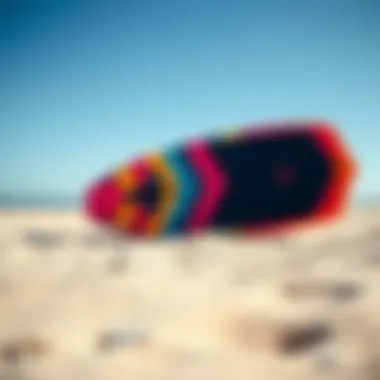
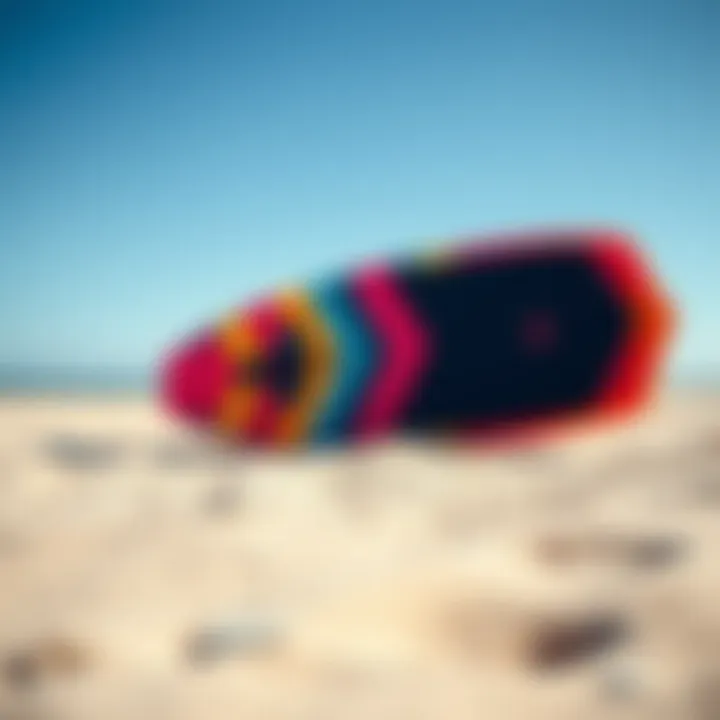
Intro
Kite surfing can feel like flying. The rush of wind and water, the adrenaline, the thrill of riding the waves—it's hard to describe unless you've experienced it. However, choosing the right kite surf board is no small potatoes. Whether you’re a greenhorn just dipping your toes into the sport, or a seasoned rider carving through waves like a pro, the board you select can either make or break your experience.
In this guide, we will explore everything from essential gear to expert tips. The aim here is to ensure you can make informed decisions to elevate your kiteboarding journey. So, let’s dive into the nitty-gritty of kite surf boards—what features to look for, maintenance tricks to keep your gear in top shape, and much more.
Equipment Insights
Latest Gear Reviews
When it comes to kite surf boards, the market continues to evolve—think wood, carbon fiber, and everything in between. A standout in 2023 is the Liquid Force Rocket. This board boasts unmatched versatility and is perfect for both flat water and choppy conditions. Another noteworthy mention is the North Reach which excels in handling wind gusts. Riders appreciate its stability during jumps and quick turns.
- Pros: These boards generally offer great stability and performance in a variety of conditions.
- Cons: They might not be as lightweight as some specialized models, which can affect performance.
Essential Gear Maintenance
Just like any other piece of equipment, your kite surf board requires regular TLC. Here are a few key tips to keep your board in prime condition:
- Rinse after use: Always rinse your board with fresh water after a session to remove salt, which can corrode your board's surface over time.
- Inspect regularly: Look for any cracks, dings, or delamination. Addressing issues early can save you from costly repairs later.
- Store properly: Keep your board out of direct sunlight and avoid extreme temperatures. A good board bag is a wise investment for protection.
Being attentive to your gear can enhance the lifespan of your board and ultimately improve its performance when you hit the water.
Regular maintenance can ensure the longevity and effectiveness of your kite surf board, helping you avoid unexpected troubles down the line.
Technique Exploration
Beginner Techniques
Starting out with kite surfing can feel like trying to learn how to walk before you can crawl. Focus on mastering the basics:
- Body Dragging: This is the art of being pulled through the water without your board. It helps you understand power and control.
- Getting Up: Another crucial step is learning to stand on your board. Start with short sessions to find your balance.
Advanced Maneuvers
For those who’ve got the basics down, it’s time to take it to a new level. Here are some techniques to explore:
- Jumping: Timing is key here. A good jump can give you both height and distance, which is what every seasoned rider aims for.
- Shove-It: This move requires a balance of edge control and kite positioning, resulting in a stylish spin that can wow your onlookers.
Engaging in advanced techniques not only boosts your skills but also multiplies the joy in kite surfing. Remember, practice makes perfect!
The journey of kite surfing is as much about the board as it is about the joy of riding itself. As you step forward, equipped with knowledge, you’ll find that every wave brings something new.
Understanding Kite Surf Boards
Kite surf boards are crucial tools for anyone looking to master the art of kiteboarding. The perfect board enhances performance, controls speed, and provides a platform for maneuverability during those breathtaking rides across the water. By understanding the ins and outs of kite surf boards, riders can make informed decisions that cater to their specific needs, ultimately improving their experience on the waves.
What is a Kite Surf Board?
At its core, a kite surf board is designed to facilitate the sport of kiteboarding, merging wind and water in an exhilarating dance. These boards are typically larger than standard surfboards and have unique characteristics that make them suitable for handling the power generated by a kite. Kite surf boards come in various shapes and sizes to match rider preferences and environmental conditions, from flat waters to waves.
Whether you’re a beginner or a seasoned kiteboarder, understanding what a kite surf board is and how it works is paramount for getting the most out of every session on the water.
Types of Kite Surf Boards
When it comes to kite surf boards, diversity reigns. Here, we break down the primary types that riders might consider:
Directional Boards
Directional boards have a pronounced shape tailored for riding in one direction, similar to traditional surfboards. This unique characteristic allows for better control and performance in waves, making them a popular choice for wave riding enthusiasts. The beauty of directional boards lies in their streamlined design, which can greatly improve a rider’s capability to carve through waves, harnessing the natural elements effectively.
However, one might find that directional boards can be less versatile than other types since they’re not designed for riding switch. This aspect can deter some riders, especially those just getting into the sport. Still, for those who revel in tackling waves head-on, directional boards shine.
Twin-Tip Boards
Twin-tip boards feature a symmetrical shape, permitting riders to comfortably roll in either direction. This quality makes them incredibly popular, particularly among those who are just stepping onto the kiteboarding scene or those who enjoy freestyle maneuvers.
The key benefit of twin-tip boards is their ease of use; riders can switch directions without missing a beat. This makes them a sensible option for learning tricks and refining skills. Yet, while their versatility is a significant advantage, experienced riders may find they lack the same level of control and performance in challenging wave conditions compared to directional models.
Foil Boards
Foil boards represent a cutting-edge evolution in kite surfing technology. They feature a hydrofoil positioned beneath the board, allowing riders to lift above the water's surface. This design is particularly beneficial in lighter wind conditions, as it reduces drag and maximizes speed and efficiency.
The thrill of foiling is palpable, as riders experience a sensation akin to flying above the water. However, mastering a foil board can prove quite challenging for newcomers, so it's often recommended that riders gain experience with traditional boards first.
Factors to Consider When Buying
When diving into the realm of kite surf boards, understanding the nuances of the purchasing process can be a game changer. It’s not just about picking a flashy design; it’s about aligning that choice with your skills, preferences, and the conditions you’ll face out on the water. Let’s break this down.
Skill Level and Experience
Your skill level is perhaps the most crucial factor to take into account. Are you a newbie taking your first steps, or are you an experienced kiteboarder with several seasons under your belt?
- For Beginners: A wider and more forgiving board can serve you well, allowing for more stability and a gentler learning curve. These boards generally provide more buoyancy, which can be a blessing when you're still mastering the basics of balance and control.
- For Pros: A more agile and responsive board might better fit your style, facilitating sharp turns and high-speed rides. Experienced kite surfers often look for boards that support tricks and maneuvers, which often means they can handle more aggressive edging and have tighter turning radiuses.
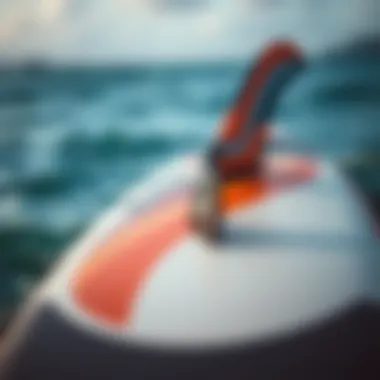
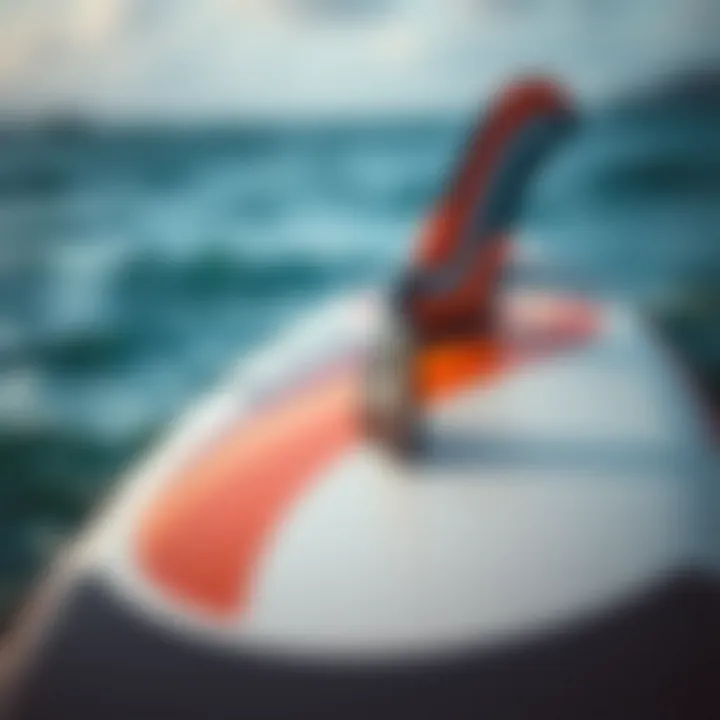
In essence, selecting a board that reflects your individual experience will drastically shape your kiteboarding journey.
Board Size and Shape
The board's dimensions and contour can significantly impact its performance, making it essential to understand.
Length and Width
Board length and width play a key role in determining how well your kite surf board performs in various conditions. A longer board tends to provide stability and smoothness, which is particularly handy in choppy waters. The key characteristic of length here is that it affords better speed due to lower drag, while a wider board enhances buoyancy and helps maintain balance, thus reducing the chances of wipeouts.
- Advantages: Greater stability and easier take-offs. These boards can help beginners stay upright with little hassle.
- Disadvantages: They might not be the best for aggressive maneuvers or tricks that experienced riders often seek, which can be frustrating if you're aiming for that next-level performance.
Rocker and Flex
Rocker refers to how much the board curves from tip to tail and it directly influences how the board rides over various conditions. Boards with a pronounced rocker can deliver a softer ride in choppy seas. Consequently, the flex of the board impacts its responsiveness. A board that flexes well can absorb shocks from hard landings and choppy conditions.
- Key Characteristics: Longer rocker boards can help in smoother transitions and better handling, while stiffer boards provide a snappier ride.
- Advantages: Enhanced ability to manage rough water, and improved turning capabilities.
- Disadvantages: Too much flex may lead to a loss of speed and control, particularly under heavier riders.
Material Considerations
The material of the board often dictates durability and overall performance. Two common materials you’ll encounter are epoxy and polyester.
Epoxy vs Polyester
Epoxy is generally known for its lightweight and strong properties, making it a popular choice overall in the kiteboarding scene. The primary characteristic of epoxy boards is their durability against dings and indentations.
- Advantages: Longevity and lightweight design, which heightens performance in air and the water.
- Disadvantages: They can come at a higher price point compared to their polyester counterparts, which might put them out of reach for some.
Polyester, meanwhile, remains a tried-and-true option—robust yet slightly heavier.
- Advantages: Typically more affordable and forgiving in terms of performance under less-than-ideal conditions.
- Disadvantages: Susceptible to dings and generally less buoyant compared to epoxy options, possibly leading to a less exhilarating experience on the water.
Durability and Weight
Durability and weight are also prominent features to consider. Lighter boards are often easier to maneuver, particularly during tricks. The trade-off, however, is in their resilience to daily wear and tear.
- Advantages: Lighter boards improve handling and are less tiring during long sessions.
- Disadvantages: They might be more fragile, requiring extra attention to maintenance.
In summary, understanding these factors will empower you in making a choice that meets your unique riding style and expectations. By focusing on what truly matters—your skill level, board dimensions, material, and how these elements combine—you'll not only enhance your kiteboarding experience, but also boost your confidence every time you hit the waves.
Top Brands in Kite Surf Board Market
When it comes to kite surfing, having a reliable and well-constructed board can make or break the entire experience. The top brands in the kite surf board market often pave the way for innovations and set quality benchmarks that others strive to meet. In this section, we'll delve into some prominent manufacturers, discussing their reputation in the market, and the unique aspects that make them stand out among the competition.
Leading Manufacturers
Airush
Airush has been making waves in the kite surfing community for quite some time now. Known for their advanced technology and quality craftsmanship, they have a reputation for being innovators in the industry. One prominent characteristic of Airush boards is their Durable Composite Technology (DCT), which enhances strength while maintaining a lightweight profile.
A significant advantage of Airush boards is their performance across a range of conditions. For kiteboarders looking for versatility, Airush caters to various skill levels with boards suited for both flat water and choppy conditions. However, their prices can sometimes put them out of reach for beginners, but many consider them a worthwhile investment due to their longevity and efficiency.
Nobile
Nobile is renowned for its focus on design and performance. They are particularly known for integrating the latest technologies into their boards, which often results in improved stability and maneuverability. A standout feature of Nobile boards is the Flex Control System, which allows riders to adjust the flex according to the riding style or conditions.
Choosing a Nobile board often appeals to those who appreciate aesthetic detail as much as functionality. Riders often rave about the responsive feel of Nobile boards, but some may find the specialized designs challenging in varied conditions, making them a more niche choice. While the artistry of their boards often captures attention, the performance speaks to serious riders who crave reliability in their gear.
Slingshot
Slingshot is another heavyweight contender in the kiteboarding realm, known for their commitment to user safety and progressive design. A unique aspect of Slingshot boards is their Single Concave Hull Design, which provides enhanced control and smoother rides over water.
One of the key selling points for Slingshot boards is their adaptability, making them suitable for both beginners and experts alike. They hold up under different conditions, translating to a fun time on the water. However, some seasoned athletes have noted that while Slingshot boards perform wonderfully, they may lack some of the speed compared to other brands. Therefore, it's crucial for potential buyers to weigh these qualities against their individual riding preferences.
Emerging Brands to Watch
As the market evolves, several emerging brands are making a name for themselves in kiteboarding. These brands often bring fresh perspectives and innovative approaches to board design. While not yet as established as the leading manufacturers, they show promise for delivering great riding experiences.
- Brand TBD: Known for their eco-friendly practices and sustainable materials.
- Brand TBD: Focuses on beginner boards with a budget-friendly approach.
- Brand TBD: Pioneers in technology, providing customizable options for advanced riders.
In summary, discussing the top brands in the kite surf board market is essential for potential buyers. Knowledge of the advantages and disadvantages enables informed choices tailored to individual preferences and riding styles.
The Importance of Board Flexibility
When you're diving into the world of kiteboarding, understanding the flexibility of your board isn’t just a footnote; it’s a cornerstone of your overall experience on the water. Board flexibility directly influences how your board handles the waves, gusts, and your riding style. There’s no question that choosing the right flex pattern can make or break your session.
Understanding Flex Patterns
Flex patterns provide a foundation for how your kite surf board interacts with the water. Generally, boards can be categorized into three types based on their flex: soft, medium, and stiff.
- Soft Flex: Ideal for beginners or freestyle riders, soft boards offer a forgiving ride. They soak up the surface's chop, making the learning curve smoother. If you’re still mastering the basics, this type of flex can help keep you upright during challenging conditions.
- Medium Flex: A balanced choice for the all-rounder. Riders who dabble in various styles may prefer boards with medium flex, as they offer a mix of speed and maneuverability. This flexibility is especially handy when transitioning from flat water to waves.
- Stiff Flex: Best suited for advanced riders who want control and responsiveness. These boards excel in performance conditions. If you're aiming for maximum speed or tackling big waves, a stiff flex will deliver the needed precision and edge hold.
Understanding these flex patterns helps kiteboarders choose a board that caters to their skill level and riding style. Whether you're carving smooth turns or launching into the air, knowing what you need is vital.
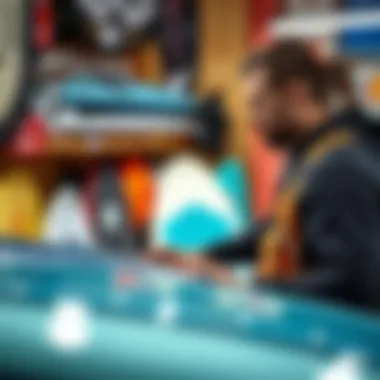

How Flex Affects Riding Experience
The relevance of flex extends beyond just handling tough waters; it plays a crucial role in how you engage with your kite surf board. Here’s how it impacts your riding experience directly:
- Shock Absorption: A board with good flex absorbs bumps and vibrations, which can be a game changer in choppy conditions. This translates to longer, smoother rides with less fatigue.
- Pop and Performance: When it comes to tricks and jumps, the right flex can provide that essential "pop" off the water. Boards designed with a bit more flex can give you the edge you need for those impressively high jumps, as they return energy efficiently.
- Stability and Control: Stiff boards, while providing speed, might sacrifice some comfort during landings. It all comes down to personal preference and riding style. A rider focused on speed might prefer a stiffer board, while one that thrives on freestyle may lean toward softer flex.
To sum it up, the way your kite surf board flexes can shape your entire experience on the water—from the comfort level to your ability to execute tricks. It’s essential to test boards with varying flex patterns and see what resonates with your personal riding style.
"Understanding board flexibility is akin to knowing your own strengths in kiteboarding."
If you’re in doubt about where to start, engaging with local riders or visiting kiteboarding forums on platforms like Reddit can provide insights and personal experiences that might guide your decision further. Resources like Wikipedia offer foundational knowledge, while discussions on Facebook may present real-time feedback from fellow kiteboarders.
Adapting the flex of your board to your skills can lead not only to better performance, but also increased enjoyment on your kiteboarding adventures. Dive in and experiment until you find your perfect fit.
Maintenance and Care for Your Kite Surf Board
Taking care of your kite surf board is just as crucial as selecting the right one. After all, proper maintenance ensures longevity and peak performance. Think of your board as an investment—like any asset, you need to take time and effort to keep it in shape.
When it comes to kite surf boards, neglecting maintenance can lead to diminished performance or even accidents on the water. Therefore, regular upkeep should be a part of your routine if you want to enjoy a smooth ride for seasons to come. Let’s dive into the nitty-gritty of cleaning and storage, along with how to handle repairs and evaluate wear.
Cleaning and Storage Tips
A clean board can greatly enhance your riding experience. Here are some simple but effective tips:
- Rinse After Each Use: After riding, make sure to rinse your board with fresh water, especially if you’ve been in saltwater. Salt can corrode the edges and other materials, leading to damage over time.
- Dry Properly: Allow your board to dry completely before storing it. Leaving moisture trapped can encourage mold and mildew, which can compromise materials.
- Store Upright or on a Rack: When storing your board, keep it upright or on a rack. Laying it flat can lead to warping or pressure dents—two things you definitely want to avoid to keep your riding experience top-notch.
- Use a Board Bag: If you plan on traveling, packing your board in a padded bag will offer additional protection from dings and scratches that might occur during transit.
Repair and Upkeep
Caring for a kite surf board isn’t just about cleaning; it also involves regular repair and maintenance. If your board sustains a ding or crack, it’s essential to address it as soon as possible.
How to Repair Dings
When it comes to repairing dings, many opt to use a simple epoxy kit. The beauty of this method lies in its effectiveness and accessibility. To repair a ding, follow these key steps:
- Clean the Area: Remove any dirt or debris from the damaged area. A clean surface is essential for proper adhesion.
- Mix the Epoxy: Follow the instructions on the kit, mixing the resin and hardener as directed.
- Apply the Epoxy: Use a putty knife to apply the mixture into the ding, making sure to fill it completely.
- Sand Down: After it’s cured, sand the area smooth to match the board surface.
This repair is a popular choice due to its simplicity and effectiveness—it takes only a bit of patience and effort to salvage a damaged board. The main benefit of addressing dings swiftly is preserving the board's integrity; if left unattended, small issues can morph into bigger problems.
"A little maintenance goes a long way. Don’t wait for problems to grow—tackle them head-on!"
Evaluating Wear and Tear
Recognizing wear and tear is central to maintaining your board’s performance. Look for imperfections like cracks, severe scratches, or issues with the fins or foot straps. Regular evaluation can save you money in the long run, as catching a small issue early often prevents larger repairs later.
- Inspect Regularly: Get into the habit of examining your board after every few rides. Pay special attention to the bottom where you may notice scuff marks or scratches.
- Check the Fins and Straps: Ensure that these components are secure and not showing signs of fatigue. A loose fin can lead to instability while riding, which could be risky.
- Note Changes in Performance: If you notice a change in how your board handles or feels on the water, take a closer look. It can often indicate underlying wear that needs addressing.
Keeping an eye out for these aspects can ensure you get the most out of your kite surf board. In the end, a little diligence in maintenance goes a long way in extending your enjoyment on the water.
Market Trends in Kite Surf Boards
Understanding market trends in kite surf boards is essential for anyone looking to make a purchase, whether you're just starting out or have been riding the waves for years. These trends not only indicate what is currently popular but also highlight developments that can enhance your performance and enjoyment. Keeping an eye on the market helps buyers make informed decisions about their next board and ensures they stay ahead of the curve in this fast-paced sport.
Eco-Friendly Innovations
Kite surfing is increasingly intertwined with environmental consciousness. Eco-friendly innovations have surfaced, showing that manufacturers are taking steps to lessen their ecological footprint. You might find boards made from sustainable materials, like recycled plastics or organic natural fibers. These boards not only do a favor for the planet, but they can also enhance your riding experience.
For instance, many brands are using bio-resins that cut down on harmful emissions during production. This shift not only helps the environment but also appeals to a growing demographic that prioritizes sustainability in their purchases. It's a win-win situation.
Key eco-friendly features to look for:
- Sustainable Materials: Many manufacturers now emphasize using materials like bamboo or recycled polyesters.
- Reduced Carbon Footprint: Some companies share data on how their production process minimizes environmental impact.
- Recyclable Components: Boards that can be recycled post-use are gaining traction as younger consumers become more environmentally aware.
Technological Advancements
The kite surf board industry has seen rapid changes thanks to technological advancements. Each season, innovations emerge that can significantly refine your performance on the water. For example, boards equipped with new designs aimed at improving aerodynamics enable better speed and maneuverability.
The introduction of smart technology is also making waves. Some companies have started incorporating sensors that track your performance metrics, such as speed and jump height, giving riders real-time feedback. This can help you refine your skills and tailor your practice routines efficiently.
Here’s what to consider when it comes to tech advancements:
- Enhanced Durability: New materials that withstand wear and tear are now commonplace.
- Weight Reduction: Innovations have led to lighter boards which provide better handling and less fatigue during extended rides.
- Customizable Options: The rise in 3D printing technology allows for more personalized settings in board design to match individual riding styles.
The kite surfing community is vibrant, evolving with every season, embracing both eco-responsibility and technological progress. Knowing these trends not only positions you as an informed buyer but also enhances your overall kiteboarding experience.
Buying Options: Where to Purchase
When it comes to purchasing a kite surf board, knowing where to buy can greatly influence your experience and investment. The importance of this topic cannot be overstated, as it shapes your overall satisfaction with the product you choose. Decisions about whether to visit a local shop or click through an online retailer can affect factors such as customer service, board continuity in checking the condition of items, prices, and sometimes even the availability of specific models.
Local Shops vs Online Retailers
Buying locally offers tangible benefits; you can feel the board, check its weight, and inspect it for quality firsthand. Plus, there's the invaluable opportunity to converse with staff who often share their years of expertise, guiding you through the selection process based on your skill set and riding style.
- Pros of Local Shops:
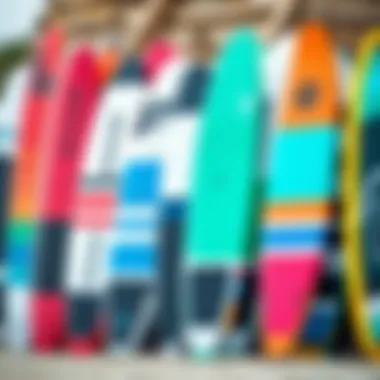
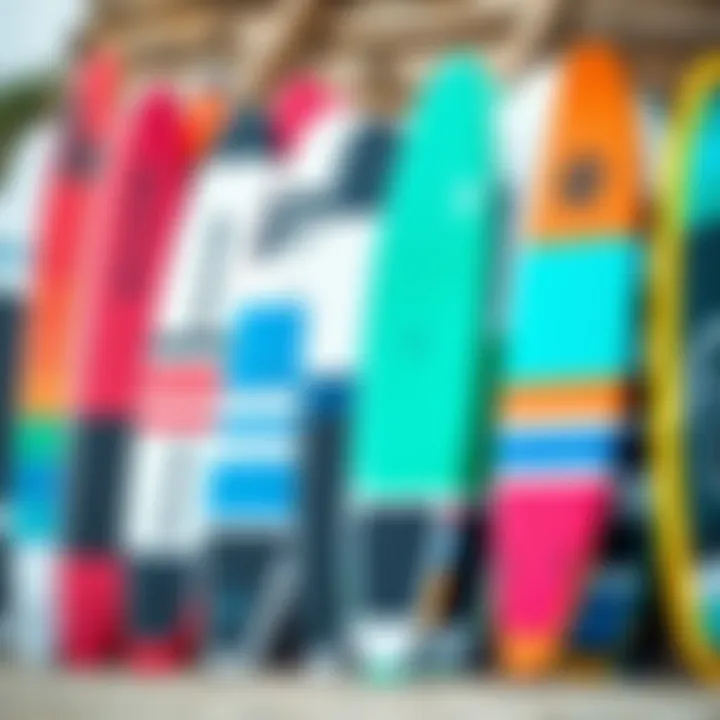
- Personalized service and advice
- Opportunity to demo boards
- Instant access to products
On the flip side, local pricing might not always be competitive. Online retailers often boast a broader selection. You can click your way through models from various brands, all from the comfort of your own home. You might even stumble upon deals that are rare in brick-and-mortar shops.
- Pros of Online Retailers:
- More extensive inventory
- Often lower prices
- Convenience of shopping from anywhere
However, purchasing online carries its own set of risks. Without the ability to check out the product physically, you might find the board isn’t what you expected once it arrives. Understanding your needs and doing some research about the board specifics can mitigate this.
Second-Hand Market Considerations
The second-hand market can be a treasure trove for kiteboarding enthusiasts looking for deals. You might uncover hidden gems, from barely-used boards to vintage collectibles that have history.
When exploring second-hand options, consider these aspects:
- Condition: Inspect for any dings, cracks, or delamination. It’s crucial to ensure that the board is still solid and won't run into issues during use.
- Age: Older boards might lack modern technology or design enhancements. It's wise to consider how a board's age correlates with your expectations for performance.
Buying second-hand can save a pretty penny, but do your homework. Make sure you’re clear on the product’s value and understand what you’re getting into.
Common Misconceptions About Kite Surf Boards
Kite surfing is an exhilarating pursuit, drawing enthusiasts from all walks of life. Yet, the sport is often clouded in myths that can steer both beginners and experienced riders off course. Addressing common misconceptions about kite surf boards not only clears up confusion but also empowers individuals to make more informed choices. Understanding the reality behind these myths can enhance one’s performance and enjoyment out on the water.
Debunking Myths
Here are some prevalent misconceptions, along with explanations to clarify them:
- Kite Boards Are Standardized
Many believe that all kite boards share similar characteristics and can be used interchangeably. This couldn’t be further from the truth. Different boards serve various conditions and riding styles. - Larger Boards Are More Stable
While it seems logical that a bigger board would offer more stability, the reality is that size affects maneuverability and glide differently. A larger board can indeed provide more surface area for floatation, especially in light winds, but it might also hinder quick turns and agile performance. Consider your skill level and local conditions before making size your sole priority. - More Flex Equals Better Performance
This myth suggests that a higher flex rating universally improves the riding experience. While flex plays an important role in the board’s responsiveness and comfort, too much flex can dampen the energy transfer needed for explosive jumps and sharp turns. It’s crucial to match the board’s flex with your riding style and skills. - You Need the Most Expensive Board for Quality
A common mindset is that splurging on high-end boards guarantees superior performance. However, skilled riders can often outperform novices on modestly priced gear. It's more beneficial to invest time learning the ins and outs of kiteboarding than to chase after the priciest option without understanding what you need.
- Directional boards are designed for surf-like conditions and provide better control during turns.
- Twin-tip boards, on the other hand, are ideal for tricks and jumps, allowing for easy riding in either direction.
"The most expensive gear won’t replace the hours of practice needed to master the sport."
By debunking these myths, we open avenues for better decision-making when selecting a kite surf board. This enables riders to focus on what really matters: enhancing their skills and enjoying the thrill of kiteboarding.
Expert Recommendations and Reviews
When it comes to acquiring the perfect kite surf board, seeking expert recommendations and reviews is invaluable. Getting insights from seasoned riders or knowledgeable instructors can provide a layer of understanding that goes beyond just specs and features. The experience captured through these perspectives helps potential buyers navigate through vast options available in the markets.
The importance of this section lies in its ability to highlight specific models that stand out due to performance and user experience. These reviews can shed light on varying aspects such as stability, maneuverability, and overall satisfaction. Particularly for beginners, learning from those who have already taken the plunge provides crucial context, guiding them to make choices aligned with their own skill levels and riding goals.
Ultimately, expert advice can act as a compass in the sometimes overwhelming sea of products.
User Testimonials
User testimonials offer an authentic glimpse into the day-to-day performance of kite surf boards. They come directly from fellow riders, providing a hands-on perspective that can be more relatable than manufacturer-produced data. For instance, if someone shares how a certain board performed during a competition or an unexpected stormy session, it can resonate with prospective buyers in ways that specifications might not.
Some notable points about user testimonials include:
- Real-world usage: Insights into how the board handles various conditions.
- Vivid experiences: Personal stories often illustrate the joys and challenges of specific models.
- Diverse opinions: Different riders share unique preferences, making it easier for others to find something that suits them.
In essence, digging into these testimonials can lead to much more informed decision-making and sometimes even save hard-earned cash from being spent on boards that do not meet expectations.
Performance Reviews of Popular Models
When discussing performance, it’s key to look at reviews meassured by experts and users alike. Performance reviews often balance technical analysis with subjective observations to deliver a well-rounded assessment. This section will delve into some stand-out models, scrutinizing their characteristics based on both expert insights and real-world testimonials.
- Airush Lift: Known for its stability and ease of use, allowing riders to perform tricks with confidence. Users often highlight its responsiveness and ability to glide smoothly across the water.
- Nobile NHP: Famed for its versatility, suitable for both freestyle and waves. Experts note its impressive pop and excellent upwind performance, essential for more intense riding conditions.
- Slingshot Model X: This particular model garners attention for being a great all-rounder. Reviewers appreciate the balance it strikes between speed and control, making it a favorite among racing enthusiasts and casual kite surfers alike.
By exploring these models through performance reviews, buyers are better equipped to align their skill levels and riding aspirations with specific products.
"Performance isn’t just about speed; it’s about how a board feels under your feet during those critical moments."
Culmination: Making an Informed Decision
Making an informed decision when it comes to kite surf boards is anchored in the understanding that your choice can significantly affect your overall experience on the water. The process isn't merely about picking the shiniest board or the one endorsed by the most popular riders; it’s a blend of personal preference, riding style, and a plethora of practical considerations.
In the world of kiteboarding, every board has its unique characteristics influenced by construction materials, design, and intended use. Evaluating the details is crucial. High-level enthusiasts might find themselves drawn to advanced features that cater to performance while beginners should lean towards more forgiving options.
When you weigh your decision, consider factors such as board size, shape, and flexibility in relation to your skill level and riding conditions. Take some time to reflect on what type of riding intrigues you—are you more inclined towards freestyle tricks or enjoying a smooth cruise across the waves? Each decision should reflect your aspirations and current capabilities.
Furthermore, keeping an eye on the market trends, user testimonials, and expert reviews can guide you toward making choices that resonate with your boarding style. Consider the environmental impact of your purchase too; an eco-friendly board might appeal to those who prioritize sustainability alongside performance.
A final thought: when you step into the world of kiteboarding, remember it’s not just about the gear you own but rather about how you utilize it, your learning curve, and how the gear supports your journey. A little bit of research can go a long way in ensuring that once you're out on the water, you’re equipped with the right tools that not only enhance your fun but also pave the way for your progression in the sport.
Evaluating Personal Preferences
Your kiteboarding experience should feel personal. Preferences in board types—be it directional boards for stability or twin-tip boards for versatility—play a pivotal role. Reflect on where you most like to ride. If you find joy in flat water, a different board may suit you than if you prefer the thrill of choppy waves or big jumps.
Additionally, color and aesthetic can also have a psychological impact; a board's design might spark excitement, further motivating you to hit the water. Choose one that resonates with you visually and functionally, as this connection can enhance your time out riding.
Final Thoughts on Your Ideal Kite Surf Board
As you sift through your options and evaluate what suits your taste, take stock of your findings and reflect on your choices. A kite surf board isn't just a purchase; it's a companion for your adventurous spirit. Your ideal board should feel like an extension of yourself—a tool that enhances not only your performance but also your enjoyment of the sport.
Consider how each board slides and carves through water, how easy it is to control during powerful gusts, and whether it allows you to execute tricks seamlessly. Once you settle on those features, visit local shops or trusted online retailers to physically check your potential purchase.
Ultimately, with the right amount of knowledge, self-reflection, and a dash of enthusiasm, selecting your kite surf board can become an exciting and rewarding venture. It’s all about finding that right balance, so you're not just buying but investing in your kiteboarding journey. To support your own path forward, you can delve further into user forums on platforms like Reddit or browse professional reviews on websites dedicated to extreme sports to glean insights on what others look for when making their choice.
Good luck, and may you choose a board that brings you endless joy on the waves!







